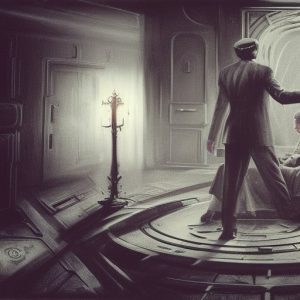
Madness is a prevalent and complex issue that plagues humanity, but there may be a ray of hope on the horizon. Advances in holodeck technology are providing us with new possibilities that could change everything we thought we knew about mental health. By creating immersive and therapeutic environments that simulate reality, patients can work alongside their therapists to confront their issues and memories, rebuilding their lives from the ground up. The benefits of this kind of therapy are numerous, offering a new ray of hope for those who have long struggled with their sanity. Although there are drawbacks, the potential for a brighter tomorrow is too great to ignore.
I. Introduction
Greetings, dear reader, and welcome to the brave new world of madness and memory retrieval therapy. Madness is an insidious thing, a creeping fog that can consume one’s entire reality and leave them lost in a maze of their own thoughts. But what if we could offer a lifeline, a way out of the labyrinth? That is where memory retrieval therapy comes in, a powerful tool that has already changed the lives of countless individuals.

By accessing long-forgotten memories, trauma can be identified and confronted, and the patient can learn to process and cope with their experiences. But what if we could take it one step further, using the latest innovations in holodeck technology to create immersive and therapeutic environments where patients can revisit their memories in a safe and supportive space?
The potential benefits of this kind of therapy are vast, allowing patients to confront and overcome their issues in a controlled, personalized environment that they can customize to fit their needs. With the help of a trained therapist, patients can work through their memories and trauma, build new coping mechanisms, and ultimately come out the other side healthier and happier than ever before.
But as with any breakthrough technology, there are always potential drawbacks and implications to consider. What if patients become addicted to the virtual worlds they inhabit, or what if the therapy creates false memories that intermingle with reality? These and other concerns must be carefully weighed and addressed for the full potential of holographic therapy to be realized.
But for now, we stand at the precipice of a new era in mental health treatment, one in which science fiction becomes fact and the impossible becomes possible. So join me on this journey to discover the truth about holodeck therapy, and let us explore the depths of our minds together, with the hope of a brighter, more stable future.
II. Understanding Madness
To truly understand the potential of holodeck therapy, we must first delve into the murky depths of madness itself. Madness is not a singular entity, but a vast and multifaceted phenomenon that can manifest itself in countless ways, depending on the individual.

At its core, madness is a breakdown of one’s connection to reality, a disruption of the delicate balance between what we believe to be true and what is objectively real. This disconnect can create a rift between what we perceive and what truly exists, and can lead to a range of symptoms such as hallucinations, delusions, and a loss of perspective.
But madness is not just a matter of perception; it is often rooted in genetic and environmental factors, and can be further exacerbated by trauma and stress. The complex interplay of these factors can make it challenging to diagnose and treat, requiring a multifaceted approach that addresses the root causes of the illness.
This is where memory retrieval therapy comes in, offering a way to access and process the experiences and emotions that contribute to madness. By identifying and confronting these sources of stress, patients can learn to manage and overcome their issues, allowing them to reconnect with reality and come to a better understanding of their place in the world.
And with the advent of holodeck therapy, we can take this process to a new level of customization and personalization, creating immersive environments that are tailored to the individual patient’s needs. By offering patients a safe, supportive space to explore their memories and emotions, we can bring them one step closer to a life free of madness and chaos.
But as with all things, there are potential dangers to consider. The very nature of madness can make it difficult to accurately assess and treat, and the added complexity of virtual reality environments can create new challenges and risks. But for those of us who have struggled with madness, the potential benefits of this technology far outweigh the risks.
III. The Science of Memory Retrieval
Let us delve further into the inner workings of memory retrieval therapy, and the science that makes it possible. Memories are the framework upon which our personalities and identities are built, shaping our thoughts, feelings, and perceptions of the world around us. But what happens when painful or traumatic experiences are buried deep within these memories, throwing our entire perception of reality off balance?

The key to overcoming this kind of trauma lies in the process of memory retrieval, a technique that allows individuals to access and confront the root of their issues head-on. This is achieved by revisiting the memory in question, coming to a better understanding of it and creating new neurological pathways in the brain that allow the individual to process and cope with the experience more effectively.
In essence, this process enables the individual to mentally ‘reprogram’ themselves, creating a new, healthier framework for their memories and emotions to exist within. And with the help of holodeck technology, this process can be taken to an entirely new level, creating an immersive experience that deeply engages the individual at a subconscious level.
But it’s not just about dredging up painful memories and rehashing old wounds. Memory retrieval therapy is a highly personalized experience that can be tailored to the individual’s specific needs and goals. By establishing a positive, supportive environment and gradually working up to more difficult memories, patients can slowly learn to process trauma and recreate a more positive outlook on life.
Of course, none of this is to say that memory retrieval therapy is a panacea for all ills. It still takes a significant amount of time, effort, and often requires the guidance of a trained professional. However, with the added benefits of holodeck technology, the potential for progress and recovery is greater than ever before. So let us boldly go into this new era of mental health treatment, with the power of memory retrieval therapy at our fingertips.
IV. The Holodeck as a Tool for Therapy
Ah, the holodeck, that venerable institution of science fiction come to life. It seems like only yesterday that we were watching Captain Picard and his crew explore the vastness of space from the comfort of their simulated surroundings. But now, thanks to advances in technology, we too can step into those virtual worlds and explore the depths of our minds in ways we never thought possible.

The holodeck’s ability to replicate specific environments and scenarios is at the heart of its therapeutic potential. For patients struggling with anxiety, for example, a holodeck could create a simulated environment where they can slowly acclimate to stressors that trigger their anxiety, while gradually building new coping mechanisms.
For individuals grappling with PTSD, the holodeck could recreate the exact environment in which their trauma occurred, allowing them to revisit the experience in a safe, controlled setting. By processing the traumatic event in this way, the patient can come to terms with their experience and integrate it healthily into their lives.
But the possibilities extend beyond just recreating traumatic events. With the ability to create any environment imaginable, the holodeck can be used for everything from relaxation to exposure therapy to skill-building. Patients can use the holodeck to practice social interactions, rehearse public speaking, or work through any number of personal issues in a way that feels safe and controlled.
Perhaps most excitingly, the holodeck’s ability to integrate with other technologies – such as biofeedback sensors or AI avatars – means that the therapy can be even more personalized and effective. By monitoring a patient’s heart rate or galvanic skin response, for example, the holodeck can automatically adjust the scenario to ensure that the patient is staying within the bounds of their comfort zone, while nudging them gently towards new challenges.
Of course, there are still limitations to the technology, and some patients may not respond as well as others to the therapy. But there is no denying the vast potential of the holodeck for mental health treatment, nor the excitement that comes with exploring uncharted territory in the field of science. Join me in the next section as we delve deeper into the possibilities – and the potential dangers – of this exciting new therapy.
V. Enhancing the Experience
But what about the future of holographic therapy, you may ask? Well, my dear readers, the future is bright indeed. Advancements in the field of artificial intelligence are leading the charge in creating ever more immersive and life-like virtual environments, allowing for an even deeper level of therapeutic benefit.

Imagine stepping into a virtual world so vivid and realistic that you forget you’re even wearing a visor. Now throw in AI beings that can interact with you in human-like ways, responding to your emotions and behavior in real-time. Suddenly, the holodeck isn’t just a tool for therapy – it’s a whole new world of experience.
This level of immersion allows the therapist and patient to work together in ways that were previously impossible, creating a level of trust and understanding that was only previously possible through years of in-person therapy. And with advancements in haptic technology, touch feedback and sensory cues allow for an even more realistic experience.
But with great power comes great responsibility. There are concerns that in creating ever-more-realistic virtual environments, patients may become addicted to their holographic worlds, preferring them to actual reality. Others worry that the lines between virtual and real could become blurred, leading to confusion and even existential crises.
Nevertheless, we must forge ahead, exploring the full potential of this exciting new frontier in mental health treatment. With the power of advanced AI and ever-evolving technology at our fingertips, we stand on the brink of a new era of holographic therapy, one that could transform mental health for generations to come.
VI. Potential Drawbacks and Implications
Alas, even the most innovative of technologies are not without their potential pitfalls. While holodeck therapy holds a great deal of promise for those struggling with mental health issues, it is important to consider the possible ethical and societal implications that might arise from its use.

One of the most concerning potential outcomes is the risk of creating false memories. While the technology used in holodeck therapy is highly advanced, it is still susceptible to glitches or programming errors that could result in the creation of a memory that did not actually occur. The danger of these fabricated memories bleeding into real life is not one to be taken lightly.
Another possibility, and perhaps a more insidious one, is the potential for addiction. As with any immersive and engaging technology, it is possible for patients to become so engrossed in their virtual world that they begin to lose touch with reality. While this may not seem like a significant issue at first, over time it could lead to further mental health problems and a dependence on the therapy rather than true recovery.
Finally, it is important to consider the societal implications of holodeck therapy. While it could be argued that it is a great equalizer, providing access to therapy for those who might not otherwise have it, it could also create a divide between those who can afford to participate and those who cannot. Additionally, there is the risk of a societal shift towards more reliance on technology for mental health treatment rather than personal connections and therapy.
VII. Conclusion
And so we reach the conclusion of our journey, dear reader, a journey that has taken us to the very forefront of mental health treatment technology. We have explored the potential of holodeck therapy, its ability to work alongside traditional forms of mental health care to create a more comprehensive and personalized treatment for those in need. By immersing ourselves in a virtual world that mimics reality, we can confront and process our trauma, build new coping mechanisms, and emerge stronger than ever before.

But this technology is not without its risks and drawbacks. As with any medical treatment, there is always the risk of addiction or the creation of false memories. There are ethical and societal implications to consider as well, such as the potential for patients to rely too heavily on technology instead of personal connections and the potential for those with access to this technology to gain an unfair advantage over those who do not.
However, the potential benefits of holodeck therapy far outweigh the potential risks. The ability to customize an immersive and supportive environment where patients can confront their issues and develop new ways of coping offers a new ray of hope for those struggling with mental health issues. And the potential for this technology extends far beyond just memory retrieval therapy. From anxiety and depression to PTSD and addiction, the potential applications of holographic therapy are vast and varied, offering new possibilities for treatment where traditional methods have fallen short.
So let us look to the future with hope and excitement, knowing that as technology continues to advance, mental health care can advance with it. Let us embrace this brave new world of holographic therapy, but let us do so with a mindful eye towards its limitations and drawbacks, always striving to use this technology responsibly and ethically, for the betterment of all humanity.






